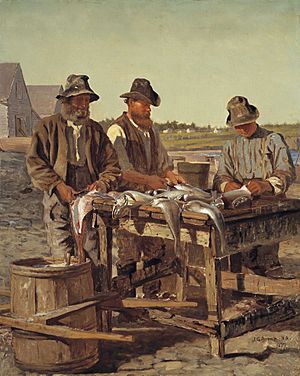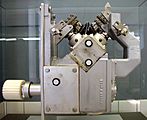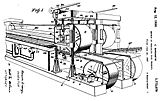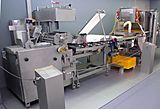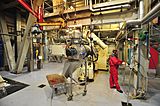Fish processing facts for kids

Fish processing has to do with fish and fish products between the time fish are caught or harvested, and the time the final product is delivered to the customer. It also refers to the time when fish are caught in wild fisheries or harvested from aquaculture or fish farming.
Contents
Overview
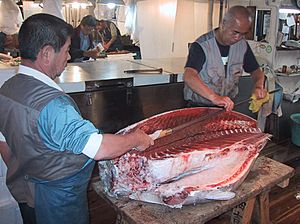
Fish is a highly perishable food which needs proper handling and preservation if it is to have a long shelf life and retain a desirable quality and nutritional value. The central concern of fish processing is to prevent fish from deteriorating. The most obvious method for preserving the quality of fish is to keep them alive until they are ready for cooking and eating. For thousands of years, China achieved this through the aquaculture of carp. Other methods used to preserve fish and fish products include
- the control of temperature using ice, refrigeration or freezing
- the control of water activity by drying, salting, smoking or freeze-drying
- the physical control of microbial loads through microwave heating or ionizing irradiation
- the chemical control of microbial loads by adding acids
- oxygen deprivation, such as vacuum packing.
Usually more than one of these methods is used. When chilled or frozen fish or fish products are transported by road, rail, sea or air, the cold chain must be maintained. This requires insulated containers or transport vehicles and adequate refrigeration. Modern shipping containers can combine refrigeration with a controlled atmosphere.
Fish processing is also concerned with proper waste management and with adding value to fish products. There is an increasing demand for ready to eat fish products, or products that do not need much preparation.
Handling the catch
When fish are captured or harvested for commercial purposes, they need some preprocessing so they can be delivered to the next part of the marketing chain in a fresh and undamaged condition. This means, for example, that fish caught by a fishing vessel need handling so they can be stored safely until the boat lands the fish on shore. Typical handling processes are
- transferring the catch from the fishing gear (such as a trawl, net or fishing line) to the fishing vessel
- holding the catch before further handling
- sorting and grading
- bleeding, gutting and washing
- chilling
- storing the chilled fish
- unloading, or landing the fish when the fishing vessel returns to port
The number and order in which these operations are undertaken varies with the fish species and the type of fishing gear used to catch it, as well as how large the fishing vessel is and how long it is at sea, and the nature of the market it is supplying. Catch processing operations can be manual or automated. The equipment and procedures in modern industrial fisheries are designed to reduce the rough handling of fish, heavy manual lifting and unsuitable working positions which might result in injuries.
Handling live fish
An alternative, and obvious way of keeping fish fresh is to keep them alive until they are delivered to the buyer or ready to be eaten. This is a common practice worldwide. Typically, the fish are placed in a container with clean water, and dead, damaged or sick fish are removed. The water temperature is then lowered and the fish are starved to reduce their metabolic rate. This decreases fouling of water with metabolic products (ammonia, nitrite and carbon dioxide) that become toxic and make it difficult for the fish to extract oxygen.
Fish can be kept alive in floating cages, wells and fish ponds. In aquaculture, holding basins are used where the water is continuously filtered and its temperature and oxygen level are controlled.
Preservation
Preservation techniques are needed to prevent fish spoilage and lengthen shelf life. They are designed to inhibit the activity of spoilage bacteria and the metabolic changes that result in the loss of fish quality. Spoilage bacteria are the specific bacteria that produce the unpleasant odours and flavours associated with spoiled fish. Fish normally host many bacteria that are not spoilage bacteria, and most of the bacteria present on spoiled fish played no role in the spoilage. To flourish, bacteria need the right temperature, sufficient water and oxygen, and surroundings that are not too acidic. Preservation techniques work by interrupting one or more of these needs. Preservation techniques can be classified as follows.
Control of temperature
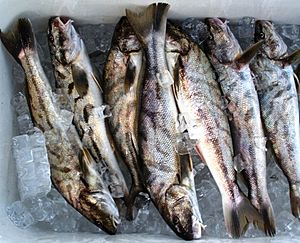
If the temperature is decreased, the metabolic activity in the fish from microbial or autolytic processes can be reduced or stopped. This is achieved by refrigeration where the temperature is dropped to about 0 °C, or freezing where the temperature is dropped below -18 °C. On fishing vessels, the fish are refrigerated mechanically by circulating cold air or by packing the fish in boxes with ice. Forage fish, which are often caught in large numbers, are usually chilled with refrigerated or chilled seawater. Once chilled or frozen, the fish need further cooling to maintain the low temperature. There are key issues with fish cold store design and management, such as how large and energy efficient they are, and the way they are insulated and palletized.
An effective method of preserving the freshness of fish is to chill with ice by distributing ice uniformly around the fish. It is a safe cooling method that keeps the fish moist and in an easily stored form suitable for transport. It has become widely used since the development of mechanical refrigeration, which makes ice easy and cheap to produce. Ice is produced in various shapes; crushed ice and ice flakes, plates, tubes and blocks are commonly used to cool fish. Particularly effective is slurry ice, made from micro crystals of ice formed and suspended within a solution of water and a freezing point depressant, such as common salt.
A more recent development is pumpable ice technology. Pumpable ice flows like water, and because it is homogeneous, it cools fish faster than fresh water solid ice methods and eliminates freeze burns. It complies with HACCP and ISO food safety and public health standards, and uses less energy than conventional fresh water solid ice technologies.
-
Fish cooling by pumpable ice
Control of water activity
The water activity, aw, in a fish is defined as the ratio of the water vapour pressure in the flesh of the fish to the vapour pressure of pure water at the same temperature and pressure. It ranges between 0 and 1, and is a parameter that measures how available the water is in the flesh of the fish. Available water is necessary for the microbial and enzymatic reactions involved in spoilage. There are a number of techniques that have been or are used to tie up the available water or remove it by reducing the aw.
Traditionally, techniques such as drying, salting and smoking have been used, and have been used for thousands of years. These techniques can be very simple, for example, by using solar drying. In more recent times, freeze-drying, water binding humectants, and fully automated equipment with temperature and humidity control have been added. Often a combination of these techniques is used.
-
Fish barn with fish drying in the sun – Van Gogh 1882.
-
Salt fish dip at Jakarta
-
Ruins of the Port Eynon Salt House – seawater was boiled to extract salt for preserving fish
Physical control of microbial loads
Heat or ionizing irradiation can be used to kill the bacteria that cause decomposition. Heat is applied by cooking, blanching or microwave heating in a manner that pasteurizes or sterilizes fish products. Cooking or pasteurizing does not completely inactivate microorganisms and may need to be followed with refrigeration to preserve fish products and increase their shelf life. Sterilised products are stable at ambient temperatures up to 40 °C, but to ensure they remain sterilized they need packaging in metal cans or retortable pouches before the heat treatment.
Chemical control of microbial loads
Microbial growth and proliferation can be inhibited by a technique called biopreservation. Biopreservation is achieved by adding antimicrobials or by increasing the acidity of the fish muscle. Most bacteria stop multiplying when the pH is less than 4.5. Acidity is increased by fermentation, marination or by directly adding acids (acetic, citric, lactic) to fish products. Lactic acid bacteria produce the antimicrobial nisin which further enhances preservation. Other preservatives include nitrites, sulphites, sorbates, benzoates and essential oils.
Control of the oxygen reduction potential
Spoilage bacteria and lipid oxidation usually need oxygen, so reducing the oxygen around fish can increase shelf life. This is done by controlling or modifying the atmosphere around the fish, or by vacuum packaging. Controlled or modified atmospheres have specific combinations of oxygen, carbon dioxide and nitrogen, and the method is often combined with refrigeration for more effective fish preservation.
Combined techniques
Two or more of these techniques are often combined. This can improve preservation and reduce unwanted side effects such as the denaturation of nutrients by severe heat treatments. Common combinations are salting/drying, salting/marinating, salting/smoking, drying/smoking, pasteurization/refrigeration and controlled atmosphere/refrigeration. Other process combinations are currently being developed along the multiple hurdle theory.
Automated processes
"The search for higher productivity and the increase of labor cost has driven the development of computer vision technology, electronic scales and automatic skinning and filleting machines."
-
Patent issued to Clarence Birdseye for the production of quick-frozen fish, 1930
-
Processing line for fish fingers
Images for kids
-
Imitation crab and imitation shrimp made from surimi
-
A medieval view of fish processing, by Peter Brueghel the Elder (1556).
-
Filleting hake
-
Filleting sole
-
Egyptians bringing in fish and splitting them for salting


